[Repost of original posted January 4, 2015, destroyed by hosting failure.]
This one’s just for fun, mostly, but hopefully will provide a bit of perspective as well.
Arthur C. Clarke once offered his three predictions for the future, which came to be known as Clarke’s Three Laws, and the third is fairly frequently quoted in a variety of topics: “Any sufficiently advanced technology is indistinguishable from magic.” The basic idea is, were we to meet an alien race far advanced over us, or time-travelers from the distant future, or if we ourselves went back far enough into the past to meet our ancestors, the technology involved wouldn’t be considered technology, but something mystical instead. Very often, this quote (or variations of it) is presented as an incisive argument by UFO proponents, in order to explain why the observed phenomena does not display any of the traits we might expect from a craft maneuvering in our atmosphere. But I feel it’s wildly misleading, and hardly an astute observation about intelligence.
Let’s first consider what we might mean by “magic.” Going with both the encyclopedic definitions and with common usage, we take it to denote something outside of the standard laws of physics; ‘supernatural’ is sometimes used as a description. So if we apply this idea to, for instance, our present state of knowledge, we would have to see something that a) appeared to violate known laws of physics without actually doing so, or b) did violate the laws of physics, meaning that they weren’t actually laws to begin with. We’ll do these in order.
First off we should note that, as a whole, our species cannot be assigned any particular traits regarding gullibility or awe; someone who believes in ghosts might, possibly, be convinced of magic, and the deeply religious may be inclined to accept godly intervention as an explanation, but even this is up for grabs. In my experience, most people who embrace paranormal explanations do not consider them manifestations of magic, but merely physical properties that we haven’t discovered yet. Most religious folk accept physics as true, but some feel that supernatural manifestations do occur at times, mostly in aspects of otherwise improbable (but still possible) events, such as being healed from serious disease or surviving a horrendous accident. On the other hand, those members of our population known by the catch-all term “scientists” are going to be extremely hard to convince of something outside of the laws of physics, largely because they are aware how pervasive these laws are (thus “laws” in the first place,) and are more inclined to find out how something happens before pronouncing it mystical in any way; it is unlikely that “magic” will ever be an answer. If we assume Clarke was referring to humanity as a whole, then we have a very tall order to fill, bordering on impossible.
Our knowledge of physics is actually pretty tight right now – we’ve not only discovered the subatomic particles that make up atoms, but have predicted where we will find more, mostly based on our understanding of energy and conservation. We have done enough math on gravity to know that galaxies aren’t behaving properly for the amount of ‘visible’ mass they possess, and have extrapolated the existence of non-visible mass (“dark matter,”) which we have then mapped by its affect on light passing nearby. Einstein’s famous equation, E=Mc2, tells us how much binding energy can be found in atoms, and thus how much energy can possibly be extracted from any given source, and we’ve demonstrated this with matter-antimatter collisions. While there yet remain mysteries within physics, no new discovery will overturn any of this knowledge; physics might be refined, like Newton’s Laws of Motion, or even attributed to different base causes, but the bare fact that we use these every day means they are not figments of our imagination, nor unsupported hypotheses.
So we are left to imagine what could appear to violate any of the known laws, and not by a small margin but enough to be really impressive, without actually violating the laws – that’s kind of problematic. Any given atom can release a hell of a lot of energy, so appearing to exceed this is not going to be a casual observation, but require some very careful measurements. In the proposed case of visiting aliens, the ships are occasionally considered to dismiss mass and inertia effects, but very selectively; they apparently do not do so in a way that would cause them to disintegrate, or lose their solid properties for the occupants – yet these are not different properties at all, so physics would have to be extremely specific in where it paid attention (and since mass is interactive with gravity and space-time, again, we’re talking minimized effect outside of the ship but normal effect inside to prevent the occupants from vanishing in a cloud of subatomic particles.) Just proving that this was actually happening – and not merely a wild claim because UFObees cannot fathom being wrong about observations – would take some pretty specific demonstrations, and even then I cannot imagine many crying, “Magick!” rather than, “That’s so cool! How does it work?” Even something as frequently imagined as invisibility isn’t going to be magical to at least half of the people with a firm knowledge of light, since all it would require is the ability to bend photons around an object, or reproduce them on the opposite side as if nothing intervened; we actually have rudimentary technology of this sort now.
And so, we come to the next aspect, which is actually violating the laws of physics. As said previously, this would make them no longer laws, but it’s more complicated than that, since we obviously have something that’s producing these effects. So what would have to be the case is something that had a certain effect in ‘normal’ circumstances, but under the application of the right amount of energy or some special conditions, would produce a different effect. In other words, the laws still exist, but different from how we understood them. Again, this is unlikely to make anyone play the Magic card since we’ve already found wave-particle duality, and quantum entanglement – we don’t know how these occur or what properties of the universe allow them, since they go counter to everything at the atomic level on up, but they’re unmistakeably present, and not causing anyone to ward off evil spirits or start believing in pixies. We must consider that the physics we know now works quite fine from atoms all the way up to super-massive stars, both explaining and predicting with amazing accuracy, which makes the likelihood that we’re missing something fairly small. We still see no evidence of where the basic laws vanish, or produce peculiar effects, so it’s a bit of a stretch to think that there is a key to changing them someplace in there that hasn’t already been displayed.
What Clarke might have been thinking of were the curious traits best illustrated by cargo cults, and in fact, his Third Law is occasionally referenced in relation to these. While there are variations from multiple locations and time frames, the best known are a few Pacific island tribes soon after WWII, ones that had been almost entirely isolated from modern cultures and suddenly saw stunning examples of technology from their contact with military forces during the war. After the forces withdrew from the islands, the tribes thereon developed elaborate replicas of military airfields and practices, a ritualistic attempt to re-stimulate the influx of technology and trade goods that had come along with the military occupation – in essence, a religious practice aimed at the new gods of canned ham and chewing gum. [I just want to point out that these aren’t exactly cults by nearly all definitions, in that there seemed to have been no efforts to control thinking nor isolate believers from nonbelievers – these were merely new religions, just as dependent on superstitious thought and oblivious to negative results as any other religion. I imagine using the word “cult” helps a lot of people distance themselves from it though.] While Clarke’s law fits with this observed behavior to all appearances, it must be admitted that this is an extremely narrow set of circumstances, applying to a tiny percentage of the population, and a culture quite likely supportive of “magic” as an answer in the first place. A hypothesis may fit the observations, but to be strong, it should predict further observations as well; to assume that humans overall would react exactly the same way, given advanced enough technology, seems a ridiculous stretch, one hardly supported by any other evidence.
Because of all this, I can’t help but feel that Clarke’s Third Law isn’t really very apt or useful, though it remains better than the other two; the First Law implies that little or nothing is impossible, while the Second Law demonstrates a gross misunderstanding of logic. There are, almost certainly, things that are impossible – we just cannot prove such without omniscience, and assuming such might mean missing something really useful. But the physical laws we have right now exist because it has not heretofore been possible to violate them – that’s how we define laws in this usage. It may be telling that Clarke was, after all, a writer, which may mean that seeing situations in a realistic light wasn’t his first priority, or that it sometimes takes fantastic plot points to drive a story, which has been used a few times before.
* * * * *
I have a little something to add along the physics line – once again, this comes courtesy of spending time in UFO forums, an occasional and inexplicable habit of mine. But rampant therein is the belief that, given an advanced enough civilization, most laws of physics could be overcome, and there could be inertia-free craft and anti-gravity ‘fields’ and nearly unlimited sources of energy – it’s just a matter of time. While it’s a very positive outlook on technology and ingenuity, it’s not exactly realistic.
There must be properties of the universe, basic functions and traits, or there could be nothing within – we need physical laws to bind atoms together, exchange energy, keep the planet spinning, and so on. None of these could be circumvented without something else underlying to shore them up, and/or use as leverage; if we were to exceed the speed of light, there would have to be some other property that permitted the passage of time for matter, as well as something that capped the energy needed (right now it is considered infinite.) To believe that any physical laws, much less several, are able to be circumvented or changed at will is… well, not necessarily arrogant, but certainly lacking in perspective. At no time have we ever dismissed any laws; the switch from Newton’s Laws to General Relativity was simply a refinement for large scales, and Newton’s Laws work fine for 95% of the purposes we have. But we remain just a fragile collection of atoms, unable to exist outside of a narrow range of conditions, evolved to our environment and trapped within a framework of our senses – it seems bizarre to believe that we (or anything else even remotely like us) will shape the universe to our will.





















































 All of these, with one exception [didn’t I just say, “No text”?], are from this year – the exception is the first one above, since I didn’t have any sunrise shots for the gallery and haven’t gotten any in a while. That one is, like, eleven years old or so, from Florida. Most of the rest are plants, because that’s where I find the colors.
All of these, with one exception [didn’t I just say, “No text”?], are from this year – the exception is the first one above, since I didn’t have any sunrise shots for the gallery and haven’t gotten any in a while. That one is, like, eleven years old or so, from Florida. Most of the rest are plants, because that’s where I find the colors.

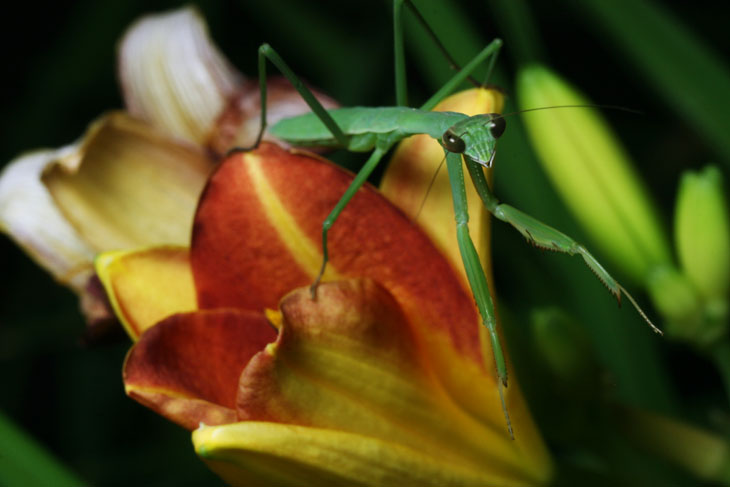



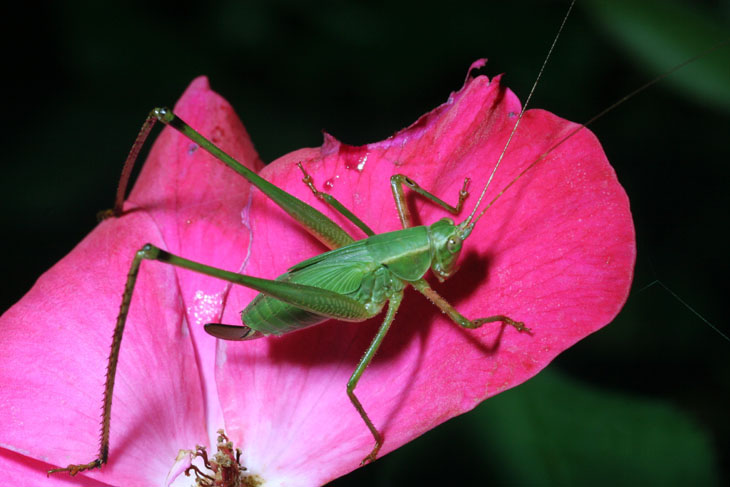









 While UNC’s Botanical Gardens are dedicated mostly to native NC plants and replicating natural habitats, this one was more decorative and landscaped. It’s all a matter of taste; I prefer the natural-looking stuff more, and actually hate most of what passes for landscaping anymore, especially the lone decorative tree in a mound of pinestraw mulch – I have no idea how that became the standard in the US, but it’s unbelievably pathetic, like using a kindergarten drawing as a decorative plan. Lest I give the wrong impression, this one was quite a bit better than that, with a pleasant layout and some real effort put into aesthetics, but it still says “artificial” too much for me. It is a favored locale for weddings and bridal shoots, but they charge a ridiculous fee just for a portrait permit, and because of this I have removed all references to them from my posts – sorry, no free advertising on this end.
While UNC’s Botanical Gardens are dedicated mostly to native NC plants and replicating natural habitats, this one was more decorative and landscaped. It’s all a matter of taste; I prefer the natural-looking stuff more, and actually hate most of what passes for landscaping anymore, especially the lone decorative tree in a mound of pinestraw mulch – I have no idea how that became the standard in the US, but it’s unbelievably pathetic, like using a kindergarten drawing as a decorative plan. Lest I give the wrong impression, this one was quite a bit better than that, with a pleasant layout and some real effort put into aesthetics, but it still says “artificial” too much for me. It is a favored locale for weddings and bridal shoots, but they charge a ridiculous fee just for a portrait permit, and because of this I have removed all references to them from my posts – sorry, no free advertising on this end.
 We’re not talking high art here, but I just wanted to point out something curious. The red in this image takes up a tiny percentage of the total area, but because it forms such a marked contrast from both its immediate surroundings and from the tones of the entire frame, it grabs attention – we notice it, but there’s no reason to look at it closely because it’s immediately apparent what it is. Since it’s there, however, it has to take a balanced place in the framing; too close to the edge, and it would seem cut off and perhaps subconsciously uncomfortable to the viewer, while putting it closer to the center implies there’s more that we should be paying attention to, without good reason. Yet without that dribble of red, the image would appear (even more) lacking in color, heavy emphasis on the grey-blue cast of overcast days – it was actually in deep shade during bright but hazy conditions, the same conditions as the weathervane pic above. It illustrates the difference between a dominant shape or subject within the frame, and a dominant contrast element, which can be quite small and still effective. It also demonstrates how small a distracting element could be – say, if this was a car in the background, or a person in a bright jacket. It is important for a photographer to see these things, not as discrete ideas like “waterfall” and “berries,” but as elements of color and contrast that will draw the eye, for good or for bad.
We’re not talking high art here, but I just wanted to point out something curious. The red in this image takes up a tiny percentage of the total area, but because it forms such a marked contrast from both its immediate surroundings and from the tones of the entire frame, it grabs attention – we notice it, but there’s no reason to look at it closely because it’s immediately apparent what it is. Since it’s there, however, it has to take a balanced place in the framing; too close to the edge, and it would seem cut off and perhaps subconsciously uncomfortable to the viewer, while putting it closer to the center implies there’s more that we should be paying attention to, without good reason. Yet without that dribble of red, the image would appear (even more) lacking in color, heavy emphasis on the grey-blue cast of overcast days – it was actually in deep shade during bright but hazy conditions, the same conditions as the weathervane pic above. It illustrates the difference between a dominant shape or subject within the frame, and a dominant contrast element, which can be quite small and still effective. It also demonstrates how small a distracting element could be – say, if this was a car in the background, or a person in a bright jacket. It is important for a photographer to see these things, not as discrete ideas like “waterfall” and “berries,” but as elements of color and contrast that will draw the eye, for good or for bad.
 On to the ducks. Yeah, I know, mallards (Anas platyrhynchos) are probably the most common duck in North America, so no remarkable skills here, but I liked the composition with the lighting, and this does show the sexual dimorphism that is common in bird species and very pronounced in many ducks – the female is in front, the male behind. The males typically have the bright, elaborate plumage to attract the attention of the females, who perform the selection of mates. The plumage is an indication of health, as well as simply standing out – even we, a completely unrelated species, can spot an unhealthy bird from a short distance. More interesting is how the colors work, since they only appear this bright in direct sunlight, having a certain refractive quality to the feathers (also note the pintail at the top of the post.) In diffuse light to shade, however, the colors almost vanish, becoming so muted they only garner a tiny percentage of the attention, allowing the birds to roost in the shade safely without sending out much of a signal to predators. As is hinted at in the image, this pair were nestled in under a tree, and only the angle of the late afternoon sun threw this bright light upon them; the same conditions (in almost the exact same location) can be seen in this
On to the ducks. Yeah, I know, mallards (Anas platyrhynchos) are probably the most common duck in North America, so no remarkable skills here, but I liked the composition with the lighting, and this does show the sexual dimorphism that is common in bird species and very pronounced in many ducks – the female is in front, the male behind. The males typically have the bright, elaborate plumage to attract the attention of the females, who perform the selection of mates. The plumage is an indication of health, as well as simply standing out – even we, a completely unrelated species, can spot an unhealthy bird from a short distance. More interesting is how the colors work, since they only appear this bright in direct sunlight, having a certain refractive quality to the feathers (also note the pintail at the top of the post.) In diffuse light to shade, however, the colors almost vanish, becoming so muted they only garner a tiny percentage of the attention, allowing the birds to roost in the shade safely without sending out much of a signal to predators. As is hinted at in the image, this pair were nestled in under a tree, and only the angle of the late afternoon sun threw this bright light upon them; the same conditions (in almost the exact same location) can be seen in this 
 Just an experiment in the bamboo grove, using a 19mm focal length, f8 with focus about 2 meters, and setting the camera on the ground aiming up, so taken blind. Out of several attempts, I like this composition best. Moreover, it shows no visible evidence of the graffiti that adorns most of the stalks, because the garden is frequented by college students who, on the whole, have not grown the fuck up yet. There’s not much you can do to bamboo when trying to carve your initials into the trunks, except produce a weak discoloration, but this is apparently enough for those who are desperate to leave their mark but lacking in any talent whatsoever – not everyone can be a pop star (really got the Old Man Thing going today, haven’t I?) I think next time I’ll go with at least f16 and a shorter focus, since it would be better to have the bottoms of the stalks in focus; the tops going out of focus would likely enhance the height aspect. Should’ve experimented more.
Just an experiment in the bamboo grove, using a 19mm focal length, f8 with focus about 2 meters, and setting the camera on the ground aiming up, so taken blind. Out of several attempts, I like this composition best. Moreover, it shows no visible evidence of the graffiti that adorns most of the stalks, because the garden is frequented by college students who, on the whole, have not grown the fuck up yet. There’s not much you can do to bamboo when trying to carve your initials into the trunks, except produce a weak discoloration, but this is apparently enough for those who are desperate to leave their mark but lacking in any talent whatsoever – not everyone can be a pop star (really got the Old Man Thing going today, haven’t I?) I think next time I’ll go with at least f16 and a shorter focus, since it would be better to have the bottoms of the stalks in focus; the tops going out of focus would likely enhance the height aspect. Should’ve experimented more.
 There is a resident great blue heron (Ardea herodias) at the gardens, quite possibly the same one I’ve photographed numerous times before, and it is remarkably mellow around the visitors. Great blues are variable species in this regard, since in most areas you’re likely to have a very hard time getting within fifty meters or so, but if they’ve become accustomed to human presence (usually through the prospect of easy food,) they might allow
There is a resident great blue heron (Ardea herodias) at the gardens, quite possibly the same one I’ve photographed numerous times before, and it is remarkably mellow around the visitors. Great blues are variable species in this regard, since in most areas you’re likely to have a very hard time getting within fifty meters or so, but if they’ve become accustomed to human presence (usually through the prospect of easy food,) they might allow 
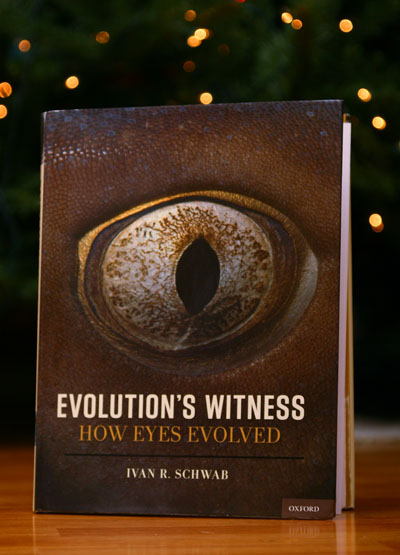
 That’s enough links to make you think I’m alternating font colors for the post, so let’s see if I can manage to avoid any more. The easiest way is by not writing much beyond this, so I’ll leave you with an appropriate image from a few days back, as one of the cats peered out from beneath the tree through a gap in the branches. This was their first christmas tree, and they were very well behaved with it though, granted, we did not put any ornaments within easy reach. They appeared to enjoy the day as well, since they had plenty of wrapping-paper balls to slap across the floor, and a Nerf-like gun shooting fascinating darts for them to chase (yes, it was my gift, and yes, I’m 49 years old – what’s your point? You got something to say?)
That’s enough links to make you think I’m alternating font colors for the post, so let’s see if I can manage to avoid any more. The easiest way is by not writing much beyond this, so I’ll leave you with an appropriate image from a few days back, as one of the cats peered out from beneath the tree through a gap in the branches. This was their first christmas tree, and they were very well behaved with it though, granted, we did not put any ornaments within easy reach. They appeared to enjoy the day as well, since they had plenty of wrapping-paper balls to slap across the floor, and a Nerf-like gun shooting fascinating darts for them to chase (yes, it was my gift, and yes, I’m 49 years old – what’s your point? You got something to say?)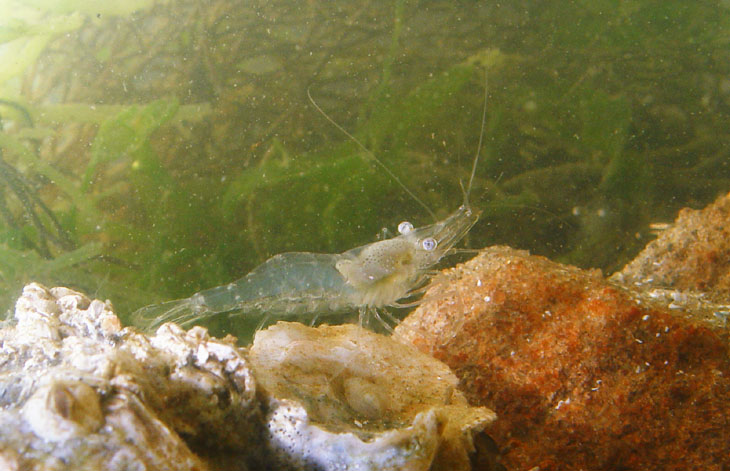
 What I had was eventually determined to be a
What I had was eventually determined to be a 
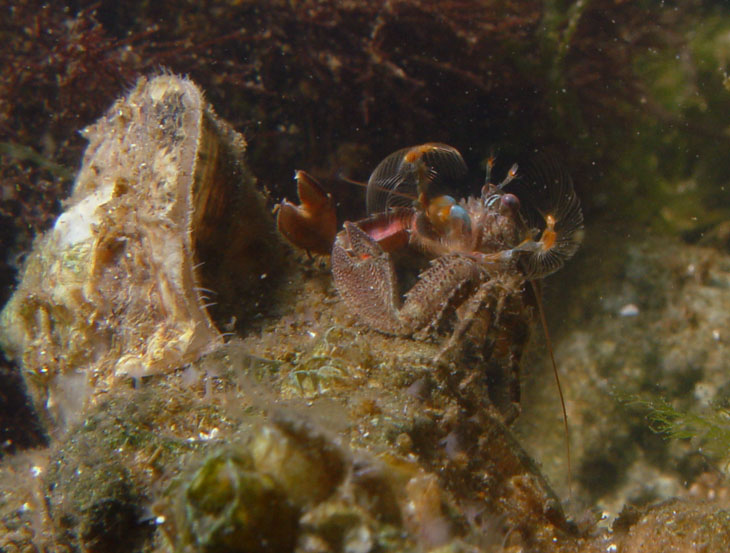

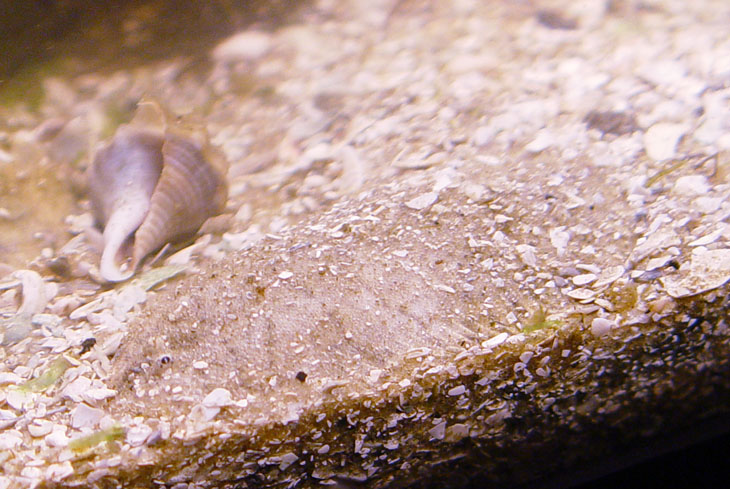



 The red rock with the snail’s eggs, seen behind the pipefish above, was a notably bare exception (though it appears in a ridiculous number of my images,) since most of the rocks I had in the aquarium were ‘living’ rock – in other words, bearing living matter thereon. I was startled to see one of the stones I collected, early on in the tank’s history, sprout a garden of little anemones soon after putting it in the water; it had spent the short trip back from the lagoon on the floor of the car out of water, because I hadn’t realized it was occupied. The anemones retract protectively when threatened and become
The red rock with the snail’s eggs, seen behind the pipefish above, was a notably bare exception (though it appears in a ridiculous number of my images,) since most of the rocks I had in the aquarium were ‘living’ rock – in other words, bearing living matter thereon. I was startled to see one of the stones I collected, early on in the tank’s history, sprout a garden of little anemones soon after putting it in the water; it had spent the short trip back from the lagoon on the floor of the car out of water, because I hadn’t realized it was occupied. The anemones retract protectively when threatened and become 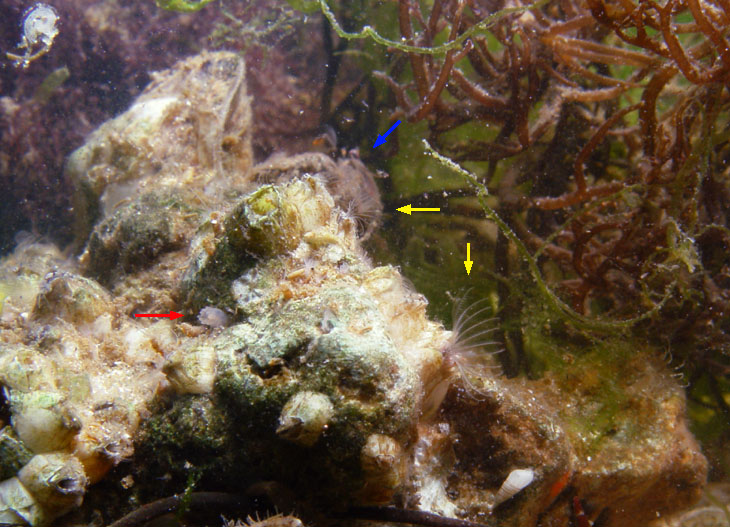



 Last year, I was making it a point to post more than I had any year earlier, and did indeed reach that mark, just a few days past this date last year. It is safe to say that I won’t be setting any records this year, since with this one I am 44 posts away, and I don’t see me knocking out, like, three posts a day from here on.
Last year, I was making it a point to post more than I had any year earlier, and did indeed reach that mark, just a few days past this date last year. It is safe to say that I won’t be setting any records this year, since with this one I am 44 posts away, and I don’t see me knocking out, like, three posts a day from here on. But I can put up a couple of images between long-winded posts, like this oak-leaf hydrangea (Hydrangea quercifolia) found at the botanical garden. I don’t think I’ve ever seen one in late fall, and I really like the effect – the leaves have a rich variety of colors, almost like those cheesy plastic fall decorations you can get at
But I can put up a couple of images between long-winded posts, like this oak-leaf hydrangea (Hydrangea quercifolia) found at the botanical garden. I don’t think I’ve ever seen one in late fall, and I really like the effect – the leaves have a rich variety of colors, almost like those cheesy plastic fall decorations you can get at  I’m continually impressed with the cold-weather hardiness of spiders. Last winter, I kept observing tiny
I’m continually impressed with the cold-weather hardiness of spiders. Last winter, I kept observing tiny